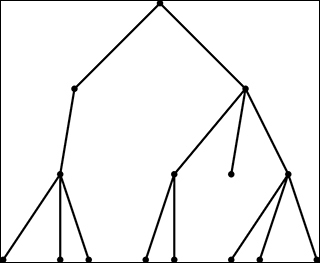
This yields a multi-dimensional extension of a limit theorem due to Janson for the number of random cuts needed to isolate the root in Galton-Watson trees conditioned by their sizes, and also generalizes a recent result obtained in the special case of Cayley trees. Our main result shows that after a proper rescaling, the cut-tree of a critical Galton-Watson tree with finite variance and conditioned to have size n, converges as n to a Brownian continuum random tree (CRT) in the weak sense induced by the Gromov-Prokhorov topology. Roughly speaking, the cut-tree then describes the genealogy of connected components appearing in this edge-deletion process. Copy AbstractĬonsider the edge-deletion process in which the edges of some finite tree T are removed one after the other in the uniform random order. Formally, branching processes allow to model a random genealogical or phylogenetic tree with a common ancestor we also say this is a rooted tree. We introduce a generalization of Galton-Watson trees where, individuals have independently a number of Poi(1 + p) offspring and, at each generation. The cut-tree of large galton-watson trees and the brownian crt. Galton-Watson process ApWe already talked about Markov models and branching process. Zbl0601.Bertoin, Jean Miermont, Grégory (2013). Self-similar fragmentations derived from the stable tree. Subdiffusive behavior of random walk on a random cluster. Die Grundlehren der Mathematischen Wissenschaften 196. Tree-valued Markov chains derived from Galton–Watson processes. Galton-Watson tree total progeny Lagrange inversion central limit theorem MSC classification Primary: 60J80: Branching processes (Galton-Watson, birth-and-death, etc. on the structure of trees with applications to supercritical Galton-Watson processes. Fragmentation associated with Lévy processes using snake. Local dimensions of the branching measure on a Galton-Watson tree. LA - eng KW - pruning branching process Galton–Watson process random tree ascension process Galton-Watson process UR - ER. Statist.34 (1998) 637–686) in the special case of Poisson offspring distributions where they considered uniform pruning of Galton–Watson trees by adding marks on the edges of trees. A similar result was obtained by Aldous and Pitman (Ann. This procedure allows us to construct and study a tree-valued Markov process (u)\rbrace $. We present a new pruning procedure on discrete trees by adding marks on the nodes of trees.

Romain Abraham Jean-François Delmas Hui HeĪnnales de l'I.H.P. Galton-Watson trees or simply generated trees are random trees that are obtained by Galton-Watson branching processes conditioned on the total progeny.1. If q 0 we recover a usual Galton-Watson tree and the survival threshold for the process has p > 0.

We first find an asymptotic estimate for the probability of a Galton-Watson tree having leaves. We introduce a generalization of Galton-Watson trees where, individuals have independently a number of Poi(1 + p) offspring and, at each generation, pairs of cousins merge independently with probability q. I am thinking of the case where we have offspring of different types. We are interested in the asymptotic behavior of critical Galton-Watson trees whose offspring distribution may have infinite variance, which are conditioned on having a large fixed number of leaves. Probabilits et statistiques 48.3 (2012): 688-705. As far as I understood, for the Galton-Watson tree process, the offspring are of one type. Pruning Galton–Watson trees and tree-valued Markov processes Pruning GaltonWatson trees and tree-valued Markov processes. In the standard case of a critical Galton-Watson tree, the limit tree has an infinite spine, where the offspring distribution is size- biased.


 0 kommentar(er)
0 kommentar(er)
